NIPT stands for Non-Invasive Prenatal Testing

It is a test to check for any chromosomal abnormalities such as Trisomy 21 (Down syndrome), Trisomy 18 (Edwards syndrome), and Trisomy 13 (Patau syndrome) in the fetus from blood samples collected from the mother.
Compared to conventional prenatal diagnosis using blood, the accuracy of the test itself is extremely high in terms of sensitivity and specificity.
Compared to conventional prenatal diagnosis using blood, the accuracy of the test itself is extremely high in terms of sensitivity and specificity.
Features and benefits of NIPT (NON-INVASIVE PRENATAL TESTING)
Risk-free to the fetus
The risk of miscarriage is 1/300 for amniotic fluid testing and 1/100 for chorionic villus testing.
NIPT is a safe test with no risk of miscarriage because the test is performed by collecting blood from the mother’s arm.

The test can be done as early as 10th week of the pregnancy cycle
Traditional non-definitive tests such as Maternal Serum Markers and Combined Tests could not be performed until after 11 weeks of pregnancy at the earliest.
NIPT (Non-Invasive Prenatal Testing) can be taken as early as 10 weeks of pregnancy, which means that the baby’s condition can be determined earlier.

High Accuracy
There are two bases for measuring the accuracy of a chromosome test.
Sensitivity, the likelihood that the test is positive among pregnant women who are positive after delivery, and specificity, the likelihood that the test is negative among those who are negative after delivery. The higher these values are, the higher the accuracy.
Concerning Trisomy 21, NIPT (Non-Invasive Prenatal Test) has a sensitivity of 99.9% and a specificity of 99.9%, so it can more accurately detect whether a baby has a possible chromosomal abnormality.
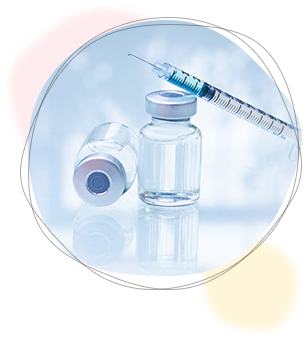
We offer various plans and options only available at our clinic, HUMEDIT NIPT, including a recommended plan and a positivity score report based on data from pregnant women who have been previously tested. Click here for more information.

Results of NIPT (Non-Invasive Prenatal Testing)
The test result is determined as ‘negative’ or ‘positive’.
However, the test may not be performed if the amount of the baby’s DNA in the specimen (blood) does not meet the criteria or due to medications being taken.
In this case, the blood sample will be re-collected. For more information, please contact us at our free dial number.
Precautions about NIPT (Non-Invasive Prenatal Testing)
Screening tests do not give a definite yes or no answer to the test results.
Since NIPT (Non-invasive Prenatal Testing) is also a screening test, it does not indicate whether the fetus has a chromosomal disease or not, but rather whether the risk of the disease is ‘high’ or ‘low’.
In recent years, an increasing number of laboratories in Japan are offering NIPT (Non-invasive Prenatal Testing) .
However, it is important to determine in advance the differences in testing plans and testing procedures, as they vary from clinic to clinic.
To give an example, many clinics trisomy 21 (Down syndrome), trisomy 18 (Edwards syndrome) and trisomy 13 (Patau syndrome), which are the most frequently detected cases.
In addition, not all clinics perform screening tests under the same conditions. The following is an overview of the NIPT (non-invasive prenatal testing) test content:
- Positive or negative
- Aneuploidy detected or not
- Partial gene deletion or duplication
- High, intermediate, or low risk
There is no provision for NIPT (non-invasive prenatal testing) to test for all chromosome disorders and birth defects, and each institution has its version of the test.
Also, NIPT uses sex chromosome testing to determine the sex of the baby with a high accuracy. Since the sex chromosomes are not identified visually, unlike ultrasound testing, sex(gender) determination is less likely to be incorrect.
Opinions and arguments against NIPT have recently been widely covered in the media, including Japanese television and newspapers. On the other hand, public opinion and some experts have exchanged various opinions centering on ethical viewpoints. However, NIPT is not only a test to determine the risk of chromosomal abnormalities in the fetus, but also a test to determine the risk of miscarriage in the early stages of pregnancy, and NIPT is an important test to ensure a safe and healthy pregnancy period for the mother.
Cost of NIPT
1. Testing fee for NIPT
2. HUMEDIT NIPT Testing Fees
Test flow of NIPT at HUMEDIT
The testing procedures for NIPT vary widely from institution to institution.
HUMEDIT NIPT is by appointment only in order to shorten waiting time. For details, please refer to the ‘NIPT Test Guide‘.
1. Reservation
After making a reservation through our call center, confirm the information in the medical questionnaire and sign the consent form.
2. Visit the diagnostic laboratory (blood collection)
The patient will need to come to their selected scheduled date and perform the blood extraction in our partner laboratory.
3. Receive results
Results are usually delivered within 10 days after we received the blood sample.
What is Prenatal Testing?
Prenatal Testing and Prenatal Diagnosis
Prenatal testing is a test to examine the developmental status and morphological abnormalities of the baby in the womb. It is called a prenatal testing because it is performed before the birth of the baby.
Prenatal testing may be associated with genetic testing and other special tests, but prenatal testing also includes standard ultrasound examinations (echocardiography), fetal heart rate monitoring, and other tests that have been commonly performed during pregnancy checkups.
Prenatal testing can be broadly classified into visual examination for morphological and functional abnormalities, genetic and hormonal testing for fetal DNA from the mother’s blood, and amniotic fluid and chorionic villus sampling.
Given these factors, prenatal testing can be classified into two types: non-invasive tests that cause little damage to the fetus, such as ultrasound and maternal blood tests, and invasive tests that involve the risk of miscarriage, such as penetration into the mother and collection of placental tissue.
The doctor’s overall assessment of the findings of these prenatal tests is also called a ‘prenatal diagnosis’.
Purpose of Prenatal Testing
The advantage of a prenatal diagnosis is that it can prepare you for the birth of your child. Of course, it is preferable that the fetus is developing well, but a prenatal diagnosis will help to avoid and deal with unforeseen circumstances like:
- The baby is due later or earlier than usual.
- The ultrasound suggests the possibility of serious organ disease, such as heart or kidney disease.
- Genetic testing reveals a congenital metabolic or chromosomal abnormality.
- Multiple births, such as twins.
- The fetus is not facing in the normal direction in the uterus, such as a breech birth.
By obtaining the above fetal information through prenatal diagnosis, it is possible to select a delivery facility and arrange for a neonatal intensive care unit (NICU) in advance. These factors will help ensure that the newborn baby is born in the most suitable environment.
In addition, many people are concerned that if one of their relatives has a congenital disease or genetic abnormality, their baby may have a similar condition. However, advances in medical technology, such as NIPT (new prenatal diagnosis), now make it possible to determine early in pregnancy whether a fetus may have a chromosomal abnormality.
HUMEDIT NIPT’s NIPT is considered a test to respect the right of pregnant women and their families to know and to have a healthy pregnancy period and delivery. Another purpose of NIPT (Non-invasive Prenatal Testing) is to share the health status of the fetus with the couple, partner, and family before delivery, so that the whole family can prepare to welcome the baby.
Types and Characteristics of Prenatal Testing
NIPT is a new type of prenatal diagnosis, the most popular testing method in recent years, and was introduced in Japan in 2013.
The major difference of NIPT from conventional prenatal testing is that it can determine fetal chromosomal abnormalities with a high accuracy of 99.9% sensitivity and 99.9% specificity (for trisomy 21, 18, and 13), using only a blood sample from the mother, which is an extremely low-impact test.
NIPT is a non-invasive prenatal genetic test performed by drawing blood similar to a general physical examination. The fetal DNA present in the mother’s blood can be used to determine the baby’s risk of chromosomal abnormalities.
This test was made possible by the development of next-generation sequencer technology, and NIPT (non-invasive prenatal testing) is said to be the most successful test using next-generation sequencers.
The three chromosome abnormalities that can be detected by NIPT (new-type prenatal diagnosis) are trisomy 21 (Down syndrome), trisomy 18 (Edwards syndrome), and trisomy 13 (Patau syndrome), comprising 70% of all chromosome abnormalities.
NIPT (non-invasive prenatal testing) has been improved year by year, and it is now possible to determine the risk of not only trisomy 21, 18, and 13, but also sex chromosomes and all autosomal chromosome numbers from 1 to 22 with a high degree of accuracy.
For a list of diseases that can be tested for by HUMEDIT NIPT, please click here.
Cases with a large number of chromosomes (duplications) or a small number of chromosomes (deletions) can also be determined with a high degree of accuracy.
Click here for information on partial duplications and deletions.
Please note that NIPT (non-invasive prenatal testing) is not a definitive diagnosis of a baby’s chromosomal disorder, but is regarded as a non-definitive test that diagnoses the possibility of the disease. Thus, prenatal testing includes both non-confirmatory and confirmatory tests, which are also called non-invasive and invasive tests.
The differences between definitive and non-definitive tests are as follows:
| Non-definitive Test | Ultrasound examination (e.g., early NT) to evaluate for possible chromosomal disease |
|---|---|
| Maternal serum marker testing (Quattro test, triple marker test) | |
| Combined testing | |
| Maternal blood fetal chromosome test (NIPT is also classified as this test) | |
| Definitive Test | Chorionic villus examination (11-14 weeks) |
| Amniotic fluid test (after 15 weeks) |
What is a non-definitive test?
It refers to a test performed to assess whether the fetus has a possible chromosomal abnormality.
Since there is little impact on the mother and no direct invasion (damage) to the fetus, this test is known to have a very low risk of miscarriage.
These tests are called non-definitive (noninvasive) tests and several types of tests are listed. NIPT is also called a non-invasive prenatal genetic test.
Nondefinitive tests are those that determine the risk of disease from chromosomal abnormalities. Definitive tests such as amniotic fluid test and chorionic villus examination are required to make a definitive diagnosis.
The amniotic fluid test is performed after the 15th week of pregnancy, and the results are available 2 to 3 weeks later, so it may take some time before a definitive diagnosis is made.
What is ultrasound examination (echography)?
Ultrasound examination (echography) is an examination to diagnose the growth and health of the fetus in the abdomen by applying a machine on top of a jelly-like lubricant to the mother’s abdomen. This examination is performed on all pregnant women during a general pregnancy examination.
Ultrasound examinations (echography) can be used to check the growth and health of the fetus at each gestational week. In 3D/4D ultrasound examinations, it is possible to detect various diseases such as heart disease, cleft palate, cleft lip, polydactyly, and renal disease.
Ultrasound examination (echography) can be performed from early to late pregnancy. However, while ultrasound can diagnose fetal malformations, it cannot diagnose chromosomal abnormalities.
In order to examine the health of the fetus in more detail, we at HUMEDIT NIPT offer a ‘chromosome screening test’ through NIPT (non-invasive prenatal testing) in addition to a visual diagnosis through ultrasound (echography).
Maternal serum marker testing (triple marker/quattro test/quattro test)
This is a method to measure fetal or placenta-derived hormones and proteins in maternal blood serum and calculate the probability of chromosomal abnormalities or open neural tube malformations in the fetus. Since the test is performed only by drawing blood from the mother, there is no direct invasion (damage) to the fetus, and the risk of miscarriage is considered to be very small.
What is a triple marker?
A blood sample is drawn from the mother to measure the levels of maternal proteins such as alpha-fetoprotein (AFP) and hormones called human chorionic gonadotropin (hCG) and unconjugated estriol (uE3). Compared to NIPT (non-invasive prenatal testing), this test is less accurate and is therefore rarely used today.
What is a Quattro Test?
This test is a triple marker with inhibin A added.
The term serum marker test in Japan refers to the Quadruple test (Quattro test). This test is performed at 15 to 17 weeks of pregnancy. It is estimated to take 7 to 10 days to get the results.
In addition, HUMEDIT NIPT does not recommend the Quattro test due to its low accuracy. Combining ultrasound examination (echography) and NIPT (non-invasive prenatal testing) covers the range of the Quattro test and provides a more accurate diagnosis.
Combined Testing
This test is a combination of NT (Nuchal Translucency) measurement by ultrasound and serum marker measurement (PAPP-A, hCG) by blood sampling, and is called a combined test because it combines the two tests.
This test was widely used until the NIPT (non-invasive prenatal testing) was introduced. Due to its low accuracy as well as the Quattro test, and the fact that the NIPT (non-invasive prenatal testing) can cover the area of combined testing, shift to NIPT (non-invasive prenatal testing) has been progressing worldwide in recent years.
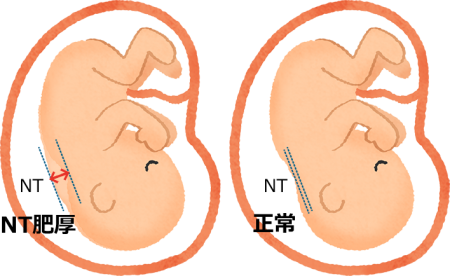
NIPT (new-type prenatal diagnosis)/non-invasive prenatal genetic testing/maternal blood fetal chromosome testing
NIPT (non-invasive prenatal testing) is one of the prenatal screening tests. It is considered a test to determine the risk of diseases caused by chromosomal abnormalities by measuring DNA fragments floating in blood collected from the mother.
NIPT (non-invasive prenatal testing) can be performed relatively early, at 10 weeks of pregnancy. It is also considered a highly accurate test with a sensitivity and specificity of 99.9% for trisomy 21 (Down syndrome). However, NIPT (non-invasive prenatal testing) is a non-definitive test. If a definitive diagnosis is desired, a definitive test such as an amniotic fluid test is required.
What is a definitive test?
A definitive test is a test to determine with certainty whether or not a disease is present. The test looks at the chromosomes themselves after culturing cells present in amniotic fluid or chorionic villi tissue.
Amniotic fluid test
In the uterus, the fetus floats in amniotic fluid. The amniotic fluid contains fetal cells. The cells in the amniotic fluid are collected and examined for changes in chromosomes and DNA. After confirming the location of the fetus by ultrasound, a needle is inserted into the mother’s abdomen and approximately 20 ml of amniotic fluid is collected. The collected cells are cultured for G-band testing and genetic testing such as qfPCR and microarray testing.
The amniotic fluid test is a definitive test, but there is about a 0.3% risk of miscarriage or water breaking because the test is performed with a needle inserted into the abdomen. It also takes approximately 2-4 weeks to receive the results.
Chorionic villus test
The Chorionic villus test is a test for genetic abnormalities by obtaining cells from the chorionic villi of fetal origin. The test can be performed early in pregnancy, but is rarely performed today because the cells are derived from the placenta and not completely from the fetus. Also, since the fetus and placenta may have different genes, HUMEDIT NIPT believes that an amniotic fluid test is necessary for an accurate diagnosis.
What can be found in NIPT (Non-invasive prenatal testing)?
Conditions and information found in NIPT (new prenatal diagnostic test) vary from institution to institution.
For example, NIPT facilities accredited by the Japan Medical Association only offer tests for trisomy 21 (Down syndrome), trisomy 18 (Edwards syndrome), and trisomy 13 (Patau syndrome).
Diseases and Test Items Identified by the NIPT (Non-invasive prenatal testing) at HUMEDIT NIPT
At HUMEDIT NIPT, we are committed to providing pregnant women with the information they desire, and we work in partnership with the Tokyo Clinical Laboratory to ensure prompt reporting of test results and the information patients request.
The tests performed at HUMEDIT NIPT will identify the following items:
For details on diseases that can be detected by the test, please refer to Diseases detected by NIPT.

All Chromosome Aneuploidy
HUMEDIT NIPT can detect aneuploidy (abnormal number of chromosomes) not only for trisomy, which consists of three chromosomes, but also for other numbers such as monosomy.
Aneuploidy of autosomes (chromosomes 1 to 22)
HUMEDIT NIPT will detect aneuploidy (abnormal number of chromosomes) not only for chromosomes 21, 18, and 13, but also for all chromosomes from chromosomes 1 to 22. As mentioned above, not only trisomy but also monosomy will be reported. We also offer a stand-alone plan, which includes testing only for chromosome 21 (Down syndrome).
Major diseases that can be detected by testing for aneuploidy of all chromosomes
- Trisomy 21 (Down syndrome)
- Trisomy 18 (Edwards syndrome)
- Trisomy 13 (Patau syndrome)
Identification of aneuploidy of sex chromosomes
With regard to sex chromosome (X and Y chromosome) aneuploidy (abnormal number of chromosomes), we will inform you of abnormalities such as Turner syndrome, a monosomy with only one X chromosome, and trisomies such as Klinefelter syndrome, which has many X chromosomes.
Sex Determination
We can let you know the sex of your baby.
In the case of twins, the assessment will be whether or not there is a Y chromosome, which will inform us whether or not there is a boy.
- Both girls
- Either one is a boy or both are boys
All autosomal whole region partial deletion/duplication syndrome
This information is not about abnormalities in the number of chromosomes such as monosomy or trisomy, but about abnormalities in which a part of the chromosome is duplicated or missing. In HUMEDIT NIPT, we will inform you if you have more than 7 million nucleotides missing or duplicated.
Each test plan has different inspection contents so please consider the plan that best suits you and your family’s needs. (Click here for information on test plans)

Principles of NIPT (Non-invasive Prenatal Testing)
Each gene is considered to be between 50-200 bp in length.
Bp is the unit for the number of A,G,T,C nucleotide sequences.
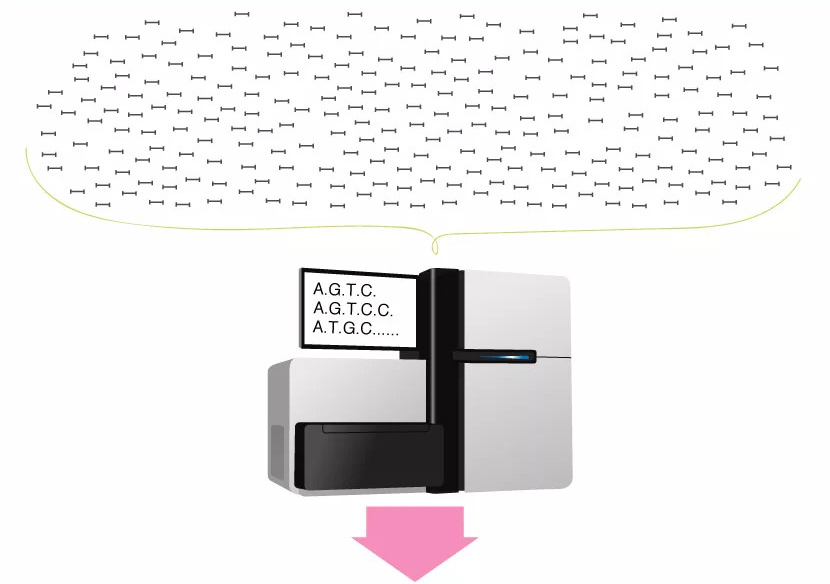
Read the gene sequence with a sequencer (sequence decoding device).
Computer analyzes which position in the
human gene it was obtained from.
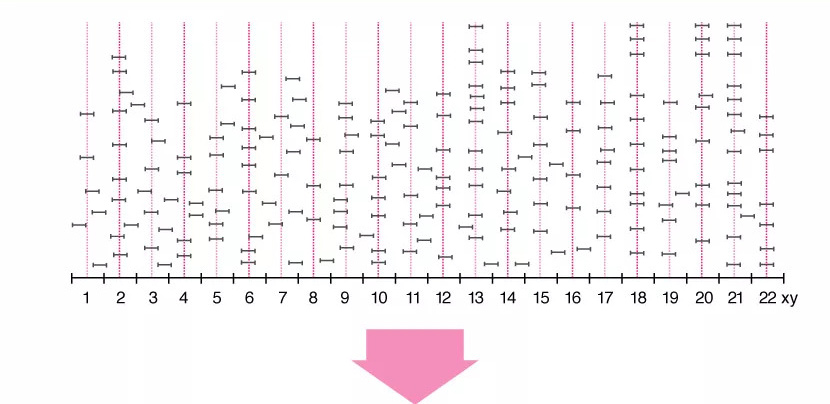
The number of sequences present in each region of the gene is measured and then
corrected to measure the distribution of gene quantity.
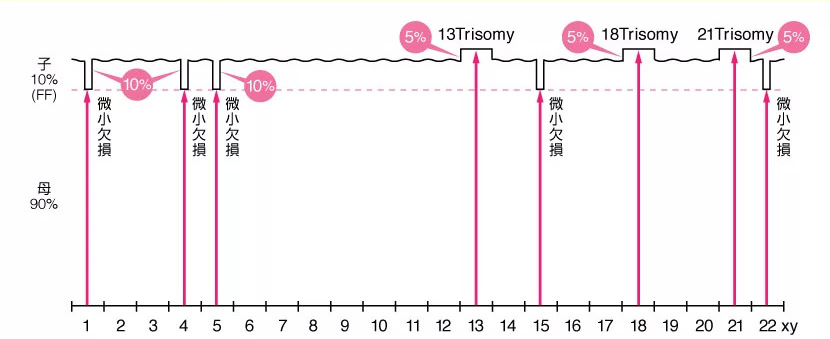
This is the length distribution of cfDNA in plasma. The blue line is cfDNA of fetal origin and the red line is total cfDNA.
This difference in length is used to determine the ratio of cfDNA of fetal origin (FF)
to the total cfDNA flowing in the mother.
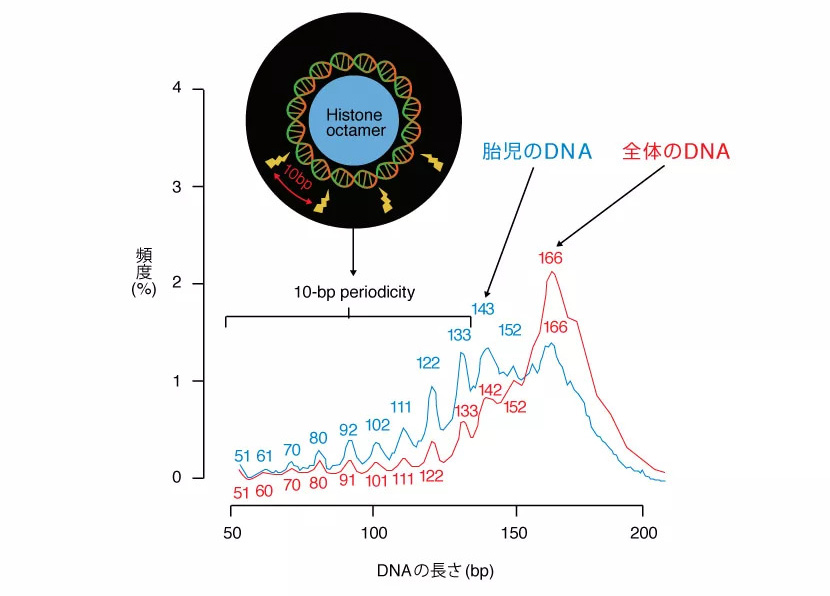
Reference: Lo YM1, Chan KC, Sun H, Chen EZ, Jiang P, Lun FM, Zheng YW, Leung TY, Lau TK, Cantor CR, Chiu RW. Maternal plasma DNA sequencing reveals the genome-wide genetic and mutational profile of the fetus.Sci Transl Med. 2010 Dec 8;2(61)
We can see that the ratio of cfDNA (FF) gradually increases as the number of weeks of gestation progresses.
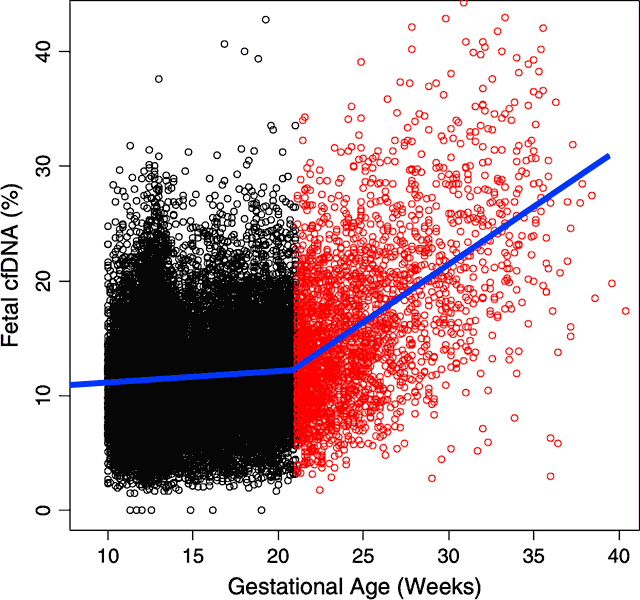
Complete chromosome Testing
HUMEDIT NIPT can test for aneuploidy of all chromosomes (chromosomes 1 to 22, X and Y) including chromosomes other than trisomy 21, trisomy 18, and trisomy 13, as well as for partial deletions and duplications of all autosomal regions.
For those who are unsure about NIPT (non-invasive prenatal tesing) for trisomy 21, trisomy 18, and trisomy 13 only, which are performed at licensed facilities, please contact HUMEDIT NIPT for consultation.
Streck tubes (blood collection tube)
HUMEDIT NIPT uses STRECK’s Cell-Free DNA BCT for blood collection tubes.
Cell-Free DNA BCT is a blood collection tube that stabilizes Cell-Free DNA at 6°C to 37°C for up to 14 days and CTCs at 15°C to 30°C for up to 7 days.
HUMEDIT NIPT’s NIPT (Non-invasive Prenatal Testing)
HUMEDIT NIPT offers a unique test based on the vast amount of data from NIPT (non-invasive prenatal testing) that have been performed to date.
By partnering with Tokyo Clinical Laboratory, HUMEDIT NIPT is able to promptly provide information to expectant mothers and their families. We also offer a variety of NIPT (Non-invasive Prenatal Testing) plans and options to satisfy and meet the needs of our patients and their families.
Many laboratories detect trisomy only, but HUMEDIT NIPT also reports monosomy. We also report diseases caused by partial deletion / duplication of all autosomal chromosomes with 7 million bases or more.
We have specialists from the Japanese Society of Obstetrics and Gynecology, and can provide ultrasound examinations (echography) prior to NIPT (non-invasive prenatal testing).Our doctors and staff are experts in NIPT (non-invasive prenatal testing), and are ready to assist anyone who needs a consultation regarding NIPT (non-invasive prenatal testing).
Please click here to see clinics where it is available.
We provide a mutual aid system for amniotic fluid testing at HUMEDIT NIPT, and those with a positive test result are eligible for a subsidy of up to 200,000 yen (including tax) for the cost of the amniotic fluid test.
In addition, our partner, Tokyo Clinical Laboratory, performs exome analysis (disease-related gene analysis) of amniotic fluid, so we can report more detailed test results by comparing the results of exome analysis and NIPT (non-invasive prenatal testing) data.
For details, please refer to Fees and Features of HUMEDIT NIPT.





